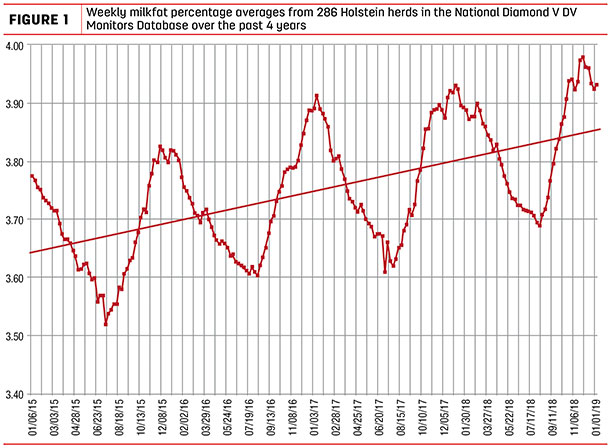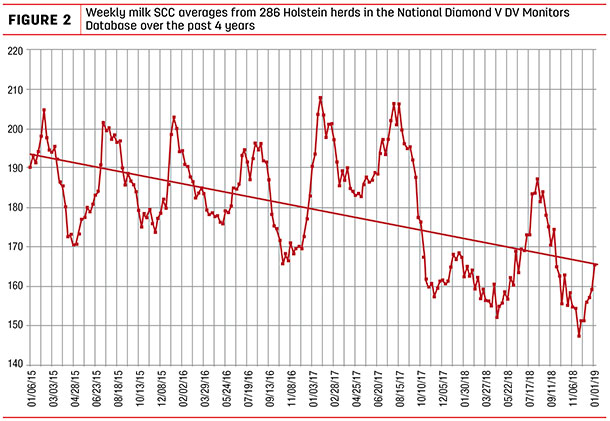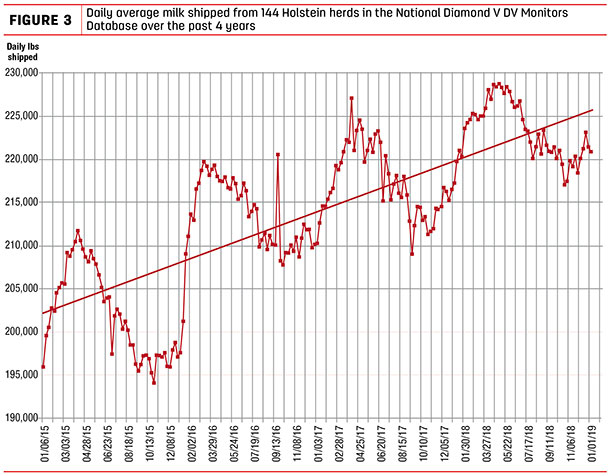The data show that over the past four years, these producers have succeeded in raising milkfat percent and lowering somatic cell count (SCC) to greatly increase their milk check. They’re also more efficient overall today versus back in 2015.
Our DV Monitors database consists of weekly weighted averages of milk components from every load of milk from producers with herds enrolled in the program. The database includes data from herds in four major dairy regions (California, Pacific Northwest, Southwest, Upper Midwest). It includes more than 280 Holstein herds, which represent a subsample of some of the best producers in the U.S. The data come directly from the milk processors and are robust enough to provide an index for producers to compare their herd’s performance with that of other leading herds within regions and across time periods.

Although dire dairy economics persist, these top producers continue to excel in factors they can control to improve their milk check – milkfat, milk SCC and daily milk shipped. We also see these top dairy producers continuing to improve their efficiency.
Milk processors have been paying more for fat than protein; they also have added incentives for low SCC or penalties for high SCC. It has been amazing to see how the herds in our DV Monitors database have responded. We have used these data to illustrate their past four years of performance, combining the regional data into three national charts covering January 2015 to January 2019.
First, note the historic highs in milkfat and lows in bulk tank SCC.
Looking at milkfat, these Holstein herds are averaging higher milkfat percentages than they did one, two and three years ago. These herds are now peaking above 3.95 percent milk fat compared to just over 3.92 percent one year ago, 3.91 percent two years ago and 3.82 percent three years ago.

Looking at SCC from the processors’ perspective, this parameter is a key indicator of milk quality – a lower SCC is better for cheese production and means a longer shelf life of bottled milk. For producers, monitoring SCC provides a way of measuring the health of their cows. Most processors pay a premium for milk with low SCC, which provides an incentive for producers to keep their cows healthy and earn a higher price compared to milk from herds with average or higher SCC. In the DV Monitors database, the SCC annual lows in 2015 were already below 170,000 but then continued to fall steadily to below 150,000 in 2018.
For an overview of production, we also charted daily bulk tank milk shipment averages from the 144 dairies that have been continuously in the database for the past four years. In addition to their advances in milkfat and SCC, today these top-performing dairies are also shipping greater amounts of quality milk. Their daily milk shipments increased significantly over these same time points from 2015 to 2019.

One of the measures of efficiency we are hearing more about lately relates to the impact of modern dairy herds on the environment. It is worth noting the dairy producers in our DV Monitors database continue to excel on the environmental front as well: They are producing more quality milk and reducing the amounts of carbon dioxide, methane, manure and other co-products per unit of milk. Today, these top producers are more efficient than ever with a smaller “carbon footprint” for the huge volumes of quality milk they produce.
The price of milk continues to be a challenge for U.S. dairy producers, and the only way for them to increase monthly milk revenue is to ship milk with higher milkfat and take advantages of premiums for low SCC. Our amazing dairy producers continue to find new ways to produce quality milk even more efficiently than they have in the past. These top producers are taking proactive approaches to sustain their businesses in a historically horrible milk market – and four years of data show their extraordinary progress. ![]()
W.K. (Bill) Sanchez, Ph.D., Dipl. ACAN, is the dairy technical service director for Diamond V and author of “DV Monitors” in the company’s Dairy Advisor newsletter, which is available at no charge.

-
Bill Sanchez
- Dairy Technical Service Director
- Diamond V
- Email Bill Sanchez






